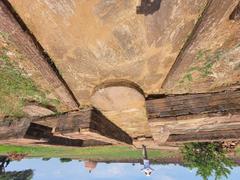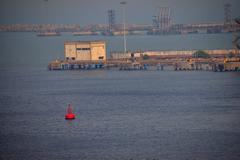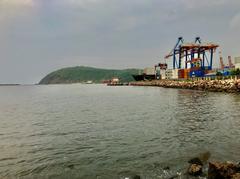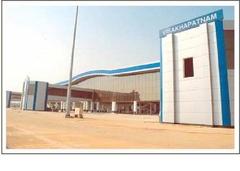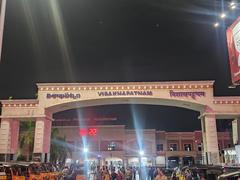
Visiting Thotlakonda: History, Tickets, and Tips
Date: 18/07/2024
Introduction
Nestled approximately 15 kilometers from Visakhapatnam, India, Thotlakonda is an awe-inspiring ancient Buddhist site that offers a deep dive into the region’s rich cultural and historical fabric. This significant archaeological site was discovered in 1976 during an aerial survey conducted by the Indian Navy. Since then, extensive excavations have uncovered a plethora of artifacts and structures that paint a vivid picture of a thriving Buddhist monastic complex that existed from the 3rd century BCE to the 3rd century CE (Archaeological Survey of India). Thotlakonda, meaning ‘Hill with Stone Wells,’ is perched on a hillock overlooking the Bay of Bengal and is home to well-preserved stupas, prayer halls, and monastic cells. Its strategic location along ancient maritime trade routes underscores its historical importance as a center for both religious practice and economic exchange during the Satavahana period (UNESCO). Whether you are a history enthusiast, a scholar, or a curious traveler, Thotlakonda promises a journey back in time, offering invaluable insights into the life and practices of an ancient Buddhist community.
Table of Contents
- [Introduction](#introductionintroduction)
- [Discover Thotlakonda](#discover-thotlakondadiscover-thotlakonda)
- [Discovery and Excavation](#discovery-and-excavationdiscovery-and-excavation)
- [Historical Significance](#historical-significancehistorical-significance)
- [Architectural Features](#architectural-featuresarchitectural-features)
- [Mahastupa](#mahastupamahastupa)
- [Vihara Complex](#vihara-complexvihara-complex)
- [Chaitya-griha](#chaitya-grihachaitya-griha)
- [Artifacts and Inscriptions](#artifacts-and-inscriptionsartifacts-and-inscriptions)
- [Pottery and Coins](#pottery-and-coinspottery-and-coins)
- [Inscriptions](#inscriptionsinscriptions)
- [Decline and Abandonment](#decline-and-abandonmentdecline-and-abandonment)
- [Practical Visitor Information](#practical-visitor-informationpractical-visitor-information)
- [Visiting Hours and Tickets](#visiting-hours-and-ticketsvisiting-hours-and-tickets)
- [Travel Tips and Accessibility](#travel-tips-and-accessibilitytravel-tips-and-accessibility)
- [Nearby Attractions](#nearby-attractionsnearby-attractions)
- [Preservation and Tourism](#preservation-and-tourismpreservation-and-tourism)
- [FAQs](#faqsfaqs)
- [Conclusion](#conclusionconclusion)
- [References](#referencesreferences)
Discover Thotlakonda
Discovery and Excavation
Thotlakonda, translating to “Hill with Stone Wells” due to the numerous rock-cut cisterns on the hill, was extensively excavated by the Andhra Pradesh State Archaeology Department between 1988 and 1992. These excavations unearthed a wealth of artifacts and structures, including stupas, chaityas (prayer halls), viharas (monastic cells), and a congregation hall, indicating that Thotlakonda was a thriving center of Buddhist learning and practice from the 3rd century BCE to the 3rd century CE (Archaeological Survey of India).
Historical Significance
Thotlakonda played a crucial role as a major Buddhist monastic complex during the Satavahana period. The Satavahanas, ruling the Deccan region from approximately 230 BCE to 220 CE, were known for their patronage of Buddhism. The monastery likely served as a hub for Buddhist monks and scholars, facilitating the spread of Buddhist teachings across the region and beyond. Its strategic location along the ancient maritime trade routes of the Bay of Bengal underscores its importance as a center for the exchange of goods and ideas, attracting traders and pilgrims from Southeast Asia and the Mediterranean (UNESCO).
Architectural Features
Thotlakonda’s architectural layout reflects the typical design of Buddhist monastic complexes of the time. The site is divided into three main zones: the Mahastupa (main stupa), the Vihara complex, and the Chaitya-griha (prayer hall).
Mahastupa
The Mahastupa, or main stupa, is the focal point of the site. Built on a raised platform and surrounded by a stone railing, the hemispherical stupa enshrined relics of the Buddha and served as a place of veneration and meditation for monks and lay followers. Smaller votive stupas around the Mahastupa indicate the practice of offering smaller stupas as a form of devotion (ASI).
Vihara Complex
The Vihara complex consists of several monastic cells arranged around a central courtyard. These simple cells, with rock-cut beds and niches for personal belongings, served as living quarters for the monks. The central courtyard likely functioned as a communal space for discussions and teachings.
Chaitya-griha
The Chaitya-griha, or prayer hall, is a rectangular structure with an apsidal end, housing a stupa at its center. The high ceiling and spacious interior facilitated congregational worship and chanting. Rock-cut pillars and intricate carvings on the walls and ceiling reflect the artistic and architectural skills of the period (UNESCO).
Artifacts and Inscriptions
Pottery and Coins
Excavations at Thotlakonda yielded a rich collection of artifacts, including pottery and coins. The pottery includes bowls, jars, and lamps, while the presence of Roman coins and amphorae fragments suggests the site’s integration into extensive trade networks, highlighting its economic prosperity during the Satavahana period (ASI).
Inscriptions
Inscriptions in Brahmi script, including donor records and religious texts, provide valuable insights into the patrons who supported the monastery and the religious activities that took place there. These inscriptions also indicate the use of Pali and Prakrit languages in Buddhist texts and teachings (UNESCO).
Decline and Abandonment
Thotlakonda’s decline as a Buddhist center around the 3rd century CE coincided with the decline of the Satavahana dynasty. A combination of political, economic, and religious factors likely contributed to its abandonment, including the rise of Hinduism and shifts in trade routes (Archaeological Survey of India).
Practical Visitor Information
Visiting Hours and Tickets
Thotlakonda is open to visitors from 9:00 AM to 6:00 PM daily. Entry is free, but donations for site preservation are welcome.
Travel Tips and Accessibility
Thotlakonda is accessible by road from Visakhapatnam. Public transport and private vehicles can be used to reach the site. Wear comfortable walking shoes and carry water, as the site involves moderate walking and exploring.
Nearby Attractions
While visiting Thotlakonda, consider exploring nearby attractions such as the Borra Caves, Kailasagiri, and the Visakha Museum, which offer further insights into the region’s rich heritage.
Preservation and Tourism
Today, Thotlakonda is a protected archaeological site under the jurisdiction of the Archaeological Survey of India. Efforts to preserve the site’s structures and artifacts have made it a popular destination for tourists and scholars interested in Buddhist history and archaeology. Informational plaques and guided tours provide insights into the site’s history and significance, making it a valuable educational experience (ASI).
FAQs
What are the visiting hours for Thotlakonda? Visiting hours are from 9:00 AM to 6:00 PM daily.
How much do tickets cost? Entry is free; however, donations for site preservation are welcome.
What are the best times to visit? The best time to visit Thotlakonda is during the cooler months from October to March.
Conclusion
Thotlakonda stands as a testament to the rich cultural and religious heritage of ancient India. Its well-preserved structures and artifacts offer a glimpse into the life and practices of a thriving Buddhist monastic community. Whether you’re a history enthusiast, a scholar, or a curious traveler, Thotlakonda promises a journey back in time, revealing the profound impact of Buddhism on the region. Plan your visit today and immerse yourself in the historical splendor of this ancient site.
References
- Archaeological Survey of India. (n.d.). https://asi.nic.in
- UNESCO. (n.d.). https://whc.unesco.org
- Andhra Pradesh Tourism. (n.d.). https://www.aptdc.gov.in
